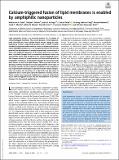| dc.contributor.author | Tahir, Mukarram A | |
| dc.contributor.author | Guven, Zekiye P. | |
| dc.contributor.author | Arriaga, Laura R. | |
| dc.contributor.author | Tinao, Berta | |
| dc.contributor.author | Yang, Yu-Sang Sabrina | |
| dc.contributor.author | Bekdemir, Ahmet | |
| dc.contributor.author | Martin, Jacob T | |
| dc.contributor.author | Bhanji, Alisha N. | |
| dc.contributor.author | Irvine, Darrell J | |
| dc.contributor.author | Stellacci, Francesco | |
| dc.contributor.author | Alexander-Katz, Alfredo | |
| dc.date.accessioned | 2020-09-08T14:31:26Z | |
| dc.date.available | 2020-09-08T14:31:26Z | |
| dc.date.issued | 2020-07 | |
| dc.date.submitted | 2019-03 | |
| dc.identifier.issn | 0027-8424 | |
| dc.identifier.issn | 1091-6490 | |
| dc.identifier.uri | https://hdl.handle.net/1721.1/127195 | |
| dc.description.abstract | Lipid membrane fusion is an essential process for a number of critical biological functions. The overall process is thermodynamically favorable but faces multiple kinetic barriers along the way. Inspired by nature's engineered proteins such as SNAP receptor [soluble N-ethylmale-imide-sensitive factor-attachment protein receptor (SNARE)] complexes or viral fusogenic proteins that actively promote the development of membrane proximity, nucleation of a stalk, and triggered expansion of the fusion pore, here we introduce a synthetic fusogen that can modulate membrane fusion and equivalently prime lipid membranes for calcium-triggered fusion. Our fusogen consists of a gold nanoparticle functionalized with an amphiphilic monolayer of alkanethiol ligands that had previously been shown to fuse with lipid bilayers. While previous efforts to develop synthetic fusogens have only replicated the initial steps of the fusion cascade, we use molecular simulations and complementary experimental techniques to demonstrate that these nanoparticles can induce the formation of a lipid stalk and also drive its expansion into a fusion pore upon the addition of excess calcium. These results have important implications in general understanding of stimuli-triggered fusion and the development of synthetic fusogens for biomedical applications. | en_US |
| dc.description.sponsorship | U.S. Department of Energy (Contract DE-FG02-97ER25308) | en_US |
| dc.description.sponsorship | National Science Foundation (Contract TG-DMR130042) | en_US |
| dc.description.sponsorship | U. S. Army Research Office (Contract W911NF-13-D-0001) | en_US |
| dc.language.iso | en | |
| dc.publisher | National Academy of Sciences | en_US |
| dc.relation.isversionof | http://dx.doi.org/10.1073/pnas.1902597117 | en_US |
| dc.rights | Article is made available in accordance with the publisher's policy and may be subject to US copyright law. Please refer to the publisher's site for terms of use. | en_US |
| dc.source | PNAS | en_US |
| dc.title | Calcium-triggered fusion of lipid membranes is enabled by amphiphilic nanoparticles | en_US |
| dc.type | Article | en_US |
| dc.identifier.citation | Tahir, Mukarram A. et al. "Calcium-triggered fusion of lipid membranes is enabled by amphiphilic nanoparticles." Proceedings of the National Academy of Sciences of the United States of America 117, 31 (August 2020): 18470-18476 © 2020 National Academy of Sciences | en_US |
| dc.contributor.department | Massachusetts Institute of Technology. Department of Materials Science and Engineering | en_US |
| dc.contributor.department | Koch Institute for Integrative Cancer Research at MIT | en_US |
| dc.relation.journal | Proceedings of the National Academy of Sciences of the United States of America | en_US |
| dc.eprint.version | Final published version | en_US |
| dc.type.uri | http://purl.org/eprint/type/JournalArticle | en_US |
| eprint.status | http://purl.org/eprint/status/PeerReviewed | en_US |
| dc.date.updated | 2020-09-02T17:16:25Z | |
| dspace.date.submission | 2020-09-02T17:16:28Z | |
| mit.journal.volume | 117 | en_US |
| mit.journal.issue | 31 | en_US |
| mit.license | PUBLISHER_POLICY | |
| mit.metadata.status | Complete | |
